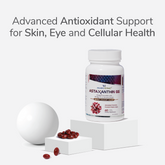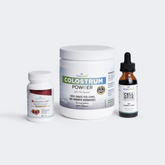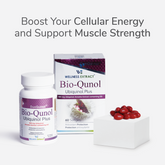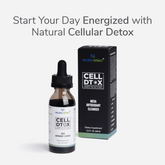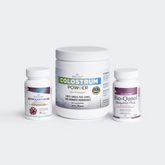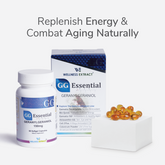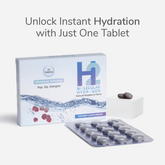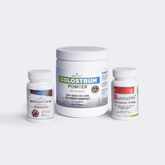Estimated Reading Time: 6 minutes
|As you age, your skin changes. It becomes thinner, drier, and more prone to wrinkles and age spots. These changes are natural, but they can also make the skin more sensitive and less able to protect you from damage.
That’s why taking good care of your skin as you age is so important, and one of the best ways to do that is by using antioxidants. One potential antioxidant is vitamin E, which helps protect the skin from damage caused by aging and environmental factors.
However, did you know that there are two main types of vitamin E? They're called tocopherols and tocotrienols, and while both help your skin, they work in different ways.
Let’s break it all down and find out which one is better for senior skin: or if you need both!
Before we talk about vitamin E, let’s look at what happens to your skin over time:
What Happens to Your Skin as You Age?
Read through these points to know:
-
Skin gets thinner: The top layers lose support from collagen and elastin, causing skin to sag and bruise more easily.
-
Less elasticity: Your skin doesn’t “bounce back” as well, especially around the neck, jawline, and eyes.
-
Dryness: Older skin produces less oil and has difficulty retaining moisture, which can lead to flakiness and irritation.
-
Wrinkles and fine lines: Repeated facial movements, sun damage, and collagen loss cause those creases and lines.
-
Age spots: Years of sun exposure can cause darker patches of skin, commonly referred to as sunspots or liver spots.
-
Slower healing: The skin takes longer to renew itself, which makes it appear dull and feel rough.
-
Less blood flow: This can cause the skin to appear pale and reduce the nutrients that help it stay healthy.
-
Increased sensitivity: The skin barrier becomes weakened, making the skin more susceptible to react to products, weather, or pollution.
Now, let's explore natural ways to address these aging issues.
Simple Ways to Take Care of Aging Skin
These tips can help slow the aging process of your skin and keep it looking radiant.
-
Wear Sunscreen Every Day
-
Drink Plenty of Water
-
Use Moisturizer Daily
-
Eat Healthy Foods
-
Use Products with Vitamins E or niacinamide
-
Avoid Smoking and Too Much Alcohol
-
Get Enough Sleep
-
Gently Exfoliate
-
Stay Out of Harsh Sun Hours
-
Manage Stress
Start early and stay consistent. These habits help protect your skin and maintain its youthfulness.
So, what's Next? Let’s explore how Vitamin E (tocopherols & tocotrienols) supports aging skin!
Vitamin E: A Skin Superhero
Vitamin E is a fat-soluble antioxidant that protects your skin from free radicals, unstable molecules caused by things like sun exposure, pollution, and natural aging. These free radicals can damage your skin cells and accelerate the aging process.
Vitamin E helps by:
-
Repairing the skin barrier
-
Keeping skin soft and smooth
-
Fighting signs of aging
But not all vitamin E is the same…
There is a 50 percent more potent form of it, aka tocotrienol.
Tocopherols vs. Tocotrienols: What’s the Difference?
Vitamin E comes in two mains: tocopherols and tocotrienol; explore their differences in below the table.
|
Aspect |
Tocopherols |
Tocotrienols |
What This Means to You |
|
Structure |
Saturated side chain |
Unsaturated side chain |
Tocotrienols work faster and better |
|
Antioxidant Power |
Moderate |
Up to 50x stronger than tocopherols |
Tocotrienols are stronger at fighting cell damage |
|
Sources |
Nuts, seeds, and vegetable oils |
Annatto, palm oil, rice bran, barley |
Tocotrienols are harder to get. |
|
Skin Benefits |
Moisturizes and protects the barrier |
Repairs skin, reduces wrinkles, UV protection |
Tocotrienols are better for anti-aging and sun protection |
|
Inflammation |
Mild anti-inflammatory effect |
Strong anti-inflammatory power |
Tocotrienols help reduce swelling better |
|
Stability in products |
Very stable |
Less stable |
Tocopherols last longer in products |
|
Penetration |
Good |
Better (smaller molecules) |
Tocotrienol goes deeper into skin or cells |
|
Availability |
Easy to find in diet and products |
Less common, usually in supplements |
Tocotrienols are rarer |
|
Cost |
Affordable |
Often more expensive |
Tocotrienols cost more but do more |
The clear winner is tocotrienol, but which one is better for senior skin? Let's dig into it.
Benefits for Senior Skin: Which One Wins?
-
Tocopherols: The Reliable Classic
Tocopherols are the most common form of vitamin E. They're found in many skincare products and can also be easily obtained from food.
Benefits:
- Help moisturize dry, flaky skin
- Strengthen the skin’s protective barrier
- Aid wound healing and reduce damage from pollution
Studies showed:
- Tocopherol helped reduce oxidative stress and skin inflammation.
-
In a clinical study tocopherol lowered IgE levels, which can be helpful for people with itchy, inflamed skin ,such as eczema.
But...
- They aren’t the most powerful antioxidants.
-
High doses of tocopherol (over 400 IU/day) may raise the risk of heart problems in people with vascular disease.
-
Tocotrienols: The Hidden Powerhouse
Tocotrienols are the lesser-known version of vitamin E, but they are more powerful.
Benefits:
- Up to 50 times better at fighting free radicals
- Strong anti-inflammatory effects
- Help repair skin damage and boost elasticity
- May protect against UV damage and support wound healing
Studies show:
- A study showed that tocotrienols helped improve skin elasticity and reduce wrinkles.
- A 2024 study found that tocotrienols protected the skin barrier and sped up wound healing.
And good news:
- Tocotrienols are safe and well-tolerated at doses up to 200 mg daily for 5 years
So...Which Should You Use?
Answer: Both, if your doctor agrees!
Tocopherols are great for moisturizing and protecting the skin, while tocotrienols offer deep repair and strong antioxidant protection.
Together, they can:
- Fight wrinkles and fine lines
- Reduce inflammation
- Improve skin texture and tone.
- Support heart and brain health.
But remember — too much of any supplement can be harmful. And don't take both at the same time. Always follow the advice of your doctor or skin care professional.
How to Get Vitamin E for Your Skin
Through Food:
- Tocopherols: Found in nuts, seeds, spinach, vegetable oils (like sunflower and wheat germ oil)
- Tocotrienols: Found in small amounts in palm oil, rice bran oil, barley, and annatto
You can get enough tocopherol from food but not tocotrienol. A diet typically provides only 2 mg of tocotrienols daily, which is insufficient for the benefits. That’s why some people take supplements.
In Skincare:
Look for products that list vitamin E, tocopherol, or tocotrienol in the ingredients. Use creams, serums, or oils with these ingredients for maximum effect.
As Supplements:
If you’re thinking about taking a supplement, always talk to your doctor first, especially if you take medications like blood thinners.
Good to know!
Taking alpha-tocopherol (a type of vitamin E) as a supplement can block the benefits of tocotrienols. But don’t worry—you usually get enough of it (about 15 mg a day) just from your regular food, so no need to take extra.
Important Safety Tips
- Too much vitamin E can cause nausea and headaches and increase the risk of bleeding.
- Tocopherols from food are safe, but supplements should be taken only in the right amount.
- If you use both, take tocotrienols and tocopherols at different time intervals to avoid interference.
Also Read: Understanding the Right Tocotrienol Dose
Final Takeaway: Best Skin Support for Seniors
You don’t have to choose between tocopherols and tocotrienols — they offer skin benefits as you age.
Here’s the golden rule:
- Tocopherols = barrier support + hydration
- Tocotrienols = deep repair + anti-aging protection
With a healthy lifestyle, balanced diet, and smart skincare choices, your skin can stay strong, smooth, and glowing — no matter your age!
Disclaimer: This article is informational and not intended as medical advice. These statements are not FDA-approved. Always consult with your doctor before making any changes to the way you manage your diabetes or take any supplements.
References
- Lonn, E. et al. (2005) 'Effects of long-term vitamin E supplementation on cardiovascular events and cancer,' JAMA, 293(11), p. 1338. https://doi.org/10.1001/jama.293.11.1338.
-
Meganathan, P. and Fu, J.-Y. (2016) 'Biological properties of tocotrienols: evidence in human studies,' International Journal of Molecular Sciences, 17(11), p. 1682. https://doi.org/10.3390/ijms17111682.
-
Naomi, R. et al. (2021) 'An interactive review on the role of tocotrienols in the neurodegenerative disorders,' Frontiers in Nutrition, 8. https://doi.org/10.3389/fnut.2021.754086.



















